Bioplastic
Bioplastics are plastics derived from renewable biomass sources, such as vegetable fats and oils, corn starch, or microbiota.[1] Bioplastic can be made from agricultural by-products and also from used plastic bottles and other containers using microorganisms. Common plastics, such as fossil-fuel plastics (also called petrobased polymers), are derived from petroleum or natural gas. Production of such plastics tends to require more fossil fuels and to produce more greenhouse gases than the production of biobased polymers (bioplastics). Some, but not all, bioplastics are designed to biodegrade. Biodegradable bioplastics can break down in either anaerobic or aerobic environments, depending on how they are manufactured. Bioplastics can be composed of starches, cellulose, biopolymers, and a variety of other materials.
Biobased polymer derived from the biomass or issued from monomers derived
from the biomass and which, at some stage in its processing into finished
products, can be shaped by flow.
Note 1: Bioplastic is generally used as the opposite of polymer derived from
fossil resources.
Note 2: Bioplastic is misleading because it suggests that any polymer derived
from the biomass is environmentally friendly.
Note 3: The use of the term "bioplastic" is discouraged. Use the expression
"biobased polymer".
Note 4: A biobased polymer similar to a petrobased one does not imply any
superiority with respect to the environment unless the comparison of respective
life cycle assessments is favourable.[2]

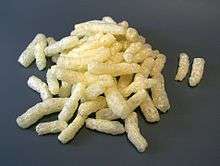

Applications
Bioplastics are used for disposable items, such as packaging, crockery, cutlery, pots, bowls, and straws.[3] They are also often used for bags, trays, fruit and vegetable containers and blister foils, egg cartons, meat packaging, vegetables, and bottling for soft drinks and dairy products.
These plastics are also used in non-disposable applications including mobile phone casings, carpet fibers, insulation car interiors, fuel lines, and plastic piping. New electroactive bioplastics are being developed that can be used to carry electric current.[4] In these areas, the goal is not biodegradability, but to create items from sustainable resources.
Medical implants made of PLA (polylactic acid), which dissolve in the body, can save patients a second operation. Compostable mulch films can also be produced from starch polymers and used in agriculture. These films do not have to be collected after use on farm fields.[5]
Biopolymers are available as coatings for paper rather than the more common petrochemical coatings.[6]
Bioplastic types
Starch-based plastics
Thermoplastic starch currently represents the most widely used bioplastic, constituting about 50 percent of the bioplastics market. Simple starch bioplastic can be made at home.[7] Pure starch is able to absorb humidity, and is thus a suitable material for the production of drug capsules by the pharmaceutical sector. Flexibiliser and plasticiser such as sorbitol and glycerine can also be added so the starch can also be processed thermo-plastically. The characteristics of the resulting bioplastic (also called "thermo-plastical starch") can be tailored to specific needs by adjusting the amounts of these additives.
Starch-based bioplastics are often blended with biodegradable polyesters to produce starch / polycaprolactone[8] or starch/Ecoflex[9] (polybutylene adipate-co-terephthalate produced by BASF[10]). blends. These blends are used for industrial applications and are also compostable. Other producers, such as Roquette, have developed other starch/polyolefin blends. These blends are not biodegradable, but have a lower carbon footprint than petroleum-based plastics used for the same applications.[11]
Cellulose-based plastics
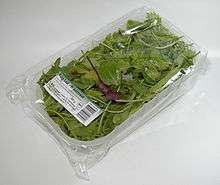
Cellulose bioplastics are mainly the cellulose esters, (including cellulose acetate and nitrocellulose) and their derivatives, including celluloid.
Protein-based plastics
Bioplastics can be made from proteins from different sources. For example wheat gluten and casein show promising properties as a raw material for different biodegradable polymers.[12]
Some aliphatic polyesters
The aliphatic biopolyesters are mainly polyhydroxyalkanoates (PHAs) like the poly-3-hydroxybutyrate (PHB), polyhydroxyvalerate (PHV) and polyhydroxyhexanoate (PHH).
Polylactic acid (PLA)
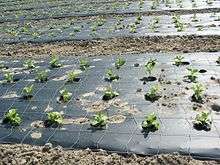
Polylactic acid (PLA) is a transparent plastic produced from corn[13] or dextrose. Its characteristics are similar to conventional petrochemical-based mass plastics (like PET, PS or PE), and it can be processed using standard equipment that already exists for the production of some conventional plastics. PLA and PLA blends generally come in the form of granulates with various properties, and are used in the plastic processing industry for the production of films, fibers, plastic containers, cups and bottles.
Poly-3-hydroxybutyrate (PHB)
The biopolymer poly-3-hydroxybutyrate (PHB) is a polyester produced by certain bacteria processing glucose, corn starch[14] or wastewater.[15] Its characteristics are similar to those of the petroplastic polypropylene. PHB production is increasing. The South American sugar industry, for example, has decided to expand PHB production to an industrial scale. PHB is distinguished primarily by its physical characteristics. It can be processed into a transparent film with a melting point higher than 130 degrees Celsius, and is biodegradable without residue.
Polyhydroxyalkanoates (PHA)
Polyhydroxyalkanoates are linear polyesters produced in nature by bacterial fermentation of sugar or lipids. They are produced by the bacteria to store carbon and energy. In industrial production, the polyester is extracted and purified from the bacteria by optimizing the conditions for the fermentation of sugar. More than 150 different monomers can be combined within this family to give materials with extremely different properties. PHA is more ductile and less elastic than other plastics, and it is also biodegradable. These plastics are being widely used in the medical industry.
Polyamide 11 (PA 11)
PA 11 is a biopolymer derived from natural oil. It is also known under the tradename Rilsan B, commercialized by Arkema. PA 11 belongs to the technical polymers family and is not biodegradable. Its properties are similar to those of PA 12, although emissions of greenhouse gases and consumption of nonrenewable resources are reduced during its production. Its thermal resistance is also superior to that of PA 12. It is used in high-performance applications like automotive fuel lines, pneumatic airbrake tubing, electrical cable antitermite sheathing, flexible oil and gas pipes, control fluid umbilicals, sports shoes, electronic device components, and catheters.
A similar plastic is Polyamide 410 (PA 410), derived 70% from castor oil, under the trade name EcoPaXX, commercialized by DSM.[16] PA 410 is a high-performance polyamide that combines the benefits of a high melting point (approx. 250 °C), low moisture absorption and excellent resistance to various chemical substances.
Bio-derived polyethylene
The basic building block (monomer) of polyethylene is ethylene. Ethylene is chemically similar to, and can be derived from ethanol, which can be produced by fermentation of agricultural feedstocks such as sugar cane or corn. Bio-derived polyethylene is chemically and physically identical to traditional polyethylene – it does not biodegrade but can be recycled. Bio derivation of polyethylene can also reduce greenhouse gas emissions considerably. Brazilian chemicals group Braskem claims that using its method of producing polyethylene from sugar cane ethanol captures (removes from the environment) 2.15 tonnes of CO2 per tonne of Green Polyethylene produced.
Green PE has the same properties, performance and application versatility as fossil-based polyethylene, which makes it a drop-in replacement in the plastic production chain. For these same reasons, it is also recyclable in the same recycling chain used by traditional polyethylene. Because it is part of the portfolio of high-density polyethylene (HDPE) and linear low-density polyethylene (LLDPE) products, Green PE is an option for applications in rigid and flexible packaging, closures, bags and other products.
Genetically modified bioplastics
Genetic modification (GM) is also a challenge for the bioplastics industry. None of the currently available bioplastics – which can be considered first generation products – require the use of GM crops, although GM corn is the standard feedstock.
Looking further ahead, some of the second generation bioplastics manufacturing technologies under development employ the "plant factory" model, using genetically modified crops or genetically modified bacteria to optimise efficiency.
Polyhydroxyurethanes
Recently, there have been a large emphasis on producing biobased and isocyanate-free polyurethanes. One such example utilizes a spontaneous reaction between polyamines and cyclic carbonates to produce polyhydroxurethanes.[17] Unlike traditional cross-linked polyurethanes, cross-linked polyhydroxyurethanes have been shown to be capable of recycling and reprocessing through dynamic transcarbamoylation reactions.[18]
Environmental impact



The environmental impact of bioplastics is often debated, as there are many different metrics for "greenness" (e.g., water use, energy use, deforestation, biodegradation, etc.) and tradeoffs often exist.[19] The debate is also complicated by the fact that many different types of bioplastics exist, each with different environmental strengths and weaknesses, so not all bioplastics can be treated as equal.
The production and use of bioplastics is sometimes regarded as a more sustainable activity when compared with plastic production from petroleum (petroplastic), because it requires less fossil fuel for its production and also introduces fewer, net-new greenhouse emissions if it biodegrades. The use of bioplastics can also result in less hazardous waste than oil-derived plastics, which remain solid for hundreds of years.
Petroleum is often still used as a source of materials and energy in the production of bioplastic. Petroleum is required to power farm machinery, to irrigate crops, to produce fertilisers and pesticides, to transport crops and crop products to processing plants, to process raw materials, and ultimately to produce the bioplastic. However, it is possible to produce bioplastic using renewable energy sources and avoid the use of petroleum.
Italian bioplastic manufacturer Novamont[20] states in its own environmental audit that producing one kilogram of its starch-based product uses 500 g of petroleum and consumes almost 80% of the energy required to produce a traditional polyethylene polymer. Environmental data from NatureWorks, the only commercial manufacturer of PLA (polylactic acid) bioplastic, says that making its plastic material delivers a fossil fuel saving of between 25 and 68 per cent compared with polyethylene, in part due to its purchasing of renewable energy certificates for its manufacturing plant.
A detailed study examining the process of manufacturing a number of common packaging items from traditional plastics and polylactic acid carried out by Franklin Associates and published by the Athena Institute shows that using bioplastic has a lower environmental impact for some products, and a higher environmental impact for others.[21] This study, however, does not factor in the end-of-life environmental impact of these products, including possible methane emissions from landfills due to biodegradable plastics.
While production of most bioplastics results in reduced carbon dioxide emissions compared to traditional alternatives, there is concern that the creation of a global bioeconomy required to produce bioplastic in large quantities could contribute to an accelerated rate of deforestation and soil erosion, and could adversely affect water supplies. Careful management of a global bioeconomy would be required.
Other studies showed that bioplastics result in a 42% reduction in carbon footprint.[22]
On October 21, 2010, a group of scientists reported that corn-based plastic ranked higher in environmental defects than the main products it replaces, such as HDPE, LDPE and PP. In the study, the production of corn-based plastics created more acidification, carcinogens, ecotoxicity, eutrophication, ozone depletion, respiratory effects and smog than the synthetic-based plastics they replaced.[23] However the study also concluded that biopolymers trumped the other plastics for biodegradability, low toxicity, and use of renewable resources.
The American Carbon Registry has also released reports of nitrous oxide caused from corn growing which is 310 times more potent than CO2. Pesticides are also used in growing corn-based plastic.[24]
Bioplastics and biodegradation
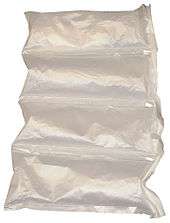
The terminology used in the bioplastics sector is sometimes misleading. Most in the industry use the term bioplastic to mean a plastic produced from a biological source. All (bio- and petroleum-based) plastics are technically biodegradable, meaning they can be degraded by microbes under suitable conditions. However, many degrade so slowly that they are considered non-biodegradable. Some petrochemical-based plastics are considered biodegradable, and may be used as an additive to improve the performance of commercial bioplastics.[25] Non-biodegradable bioplastics are referred to as durable. The biodegradability of bioplastics depends on temperature, polymer stability, and available oxygen content. The European standard EN13432, published by the International Organization for Standardization, defines how quickly and to what extent a plastic must be degraded under the tightly controlled and aggressive conditions (at or above 140 °F) of an industrial composting unit for it to be considered biodegradable. This standard is recognized in many countries, including all of Europe, Japan and the US. However, it applies only to industrial composting units and does not set out a standard for home composting. Most bioplastics (e.g. PH) only biodegrade quickly in industrial composting units. These materials do not biodegrade quickly in ordinary compost piles or in the soil/water. Starch-based bioplastics are an exception, and will biodegrade in normal composting conditions.[26]
The term "biodegradable plastic" has also been used by producers of specially modified petrochemical-based plastics that appear to biodegrade.[27] Biodegradable plastic bag manufacturers that have misrepresented their product's biodegradability may now face legal action in the US state of California for the misleading use of the terms biodegradable or compostable.[28] Traditional plastics such as polyethylene are degraded by ultra-violet (UV) light and oxygen. To prevent this, process manufacturers add stabilising chemicals. However, with the addition of a degradation initiator to the plastic, it is possible to achieve a controlled UV/oxidation disintegration process. This type of plastic may be referred to as degradable plastic or oxy-degradable plastic or photodegradable plastic because the process is not initiated by microbial action. While some degradable plastics manufacturers argue that degraded plastic residue will be attacked by microbes, these degradable materials do not meet the requirements of the EN13432 commercial composting standard. The bioplastics industry has widely criticized oxo-biodegradable plastics, which the industry association says do not meet its requirements. Oxo-biodegradable plastics – known as "oxos" – are conventional petroleum-based products with some additives that initiate degradation. The ASTM standard for oxo-biodegradables is called the Standard Guide for Exposing and Testing Plastics that Degrade in the Environment by a Combination of Oxidation and Biodegradation (ASTM 6954).[29] Both EN 13432 and ASTM 6400 are specifically designed for PLA and Starch based products and should not be used as a guide for oxos.
Market
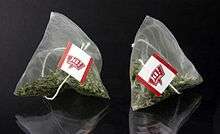
Because of the fragmentation in the market and ambiguous definitions it is difficult to describe the total market size for bioplastics, but estimates put global production capacity at 327,000 tonnes.[30] In contrast, global consumption of all flexible packaging is estimated at around 12.3 million tonnes.[31]
COPA (Committee of Agricultural Organisation in the European Union) and COGEGA (General Committee for the Agricultural Cooperation in the European Union) have made an assessment of the potential of bioplastics in different sectors of the European economy:
- Catering products: 450,000 tonnes per year
- Organic waste bags: 100,000 tonnes per year
- Biodegradable mulch foils: 130,000 tonnes per year
- Biodegradable foils for diapers 80,000 tonnes per year
- Diapers, 100% biodegradable: 240,000 tonnes per year
- Foil packaging: 400,000 tonnes per year
- Vegetable packaging: 400,000 tonnes per year
- Tyre components: 200,000 tonnes per year
- Total: 2,000,000 tonnes per year
In the years 2000 to 2008, worldwide consumption of biodegradable plastics based on starch, sugar, and cellulose – so far the three most important raw materials – has increased by 600%.[32] The NNFCC predicted global annual capacity would grow more than six-fold to 2.1 million tonnes by 2013.[30] BCC Research forecasts the global market for biodegradable polymers to grow at a compound average growth rate of more than 17 percent through 2012. Even so, bioplastics will encompass a small niche of the overall plastic market, which is forecast to reach 500 billion pounds (220 million tonnes) globally by 2010.[33] Ceresana forecasts the world market for bioplastics to reach 5.8 billion US dollars in 2021 - i.e. three times more than in 2014.[34]
Cost
At one time bioplastics were too expensive for consideration as a replacement for petroleum-based plastics. However, the lower temperatures needed to process bioplastics and the more stable supply of biomass combined with the increasing cost of crude oil make bioplastics' prices [35] more competitive with regular plastics.
Research and development
- In the early 1950s, amylomaize (>50% amylose content corn) was successfully bred and commercial bioplastics applications started to be explored.
- In 2004, NEC developed a flame retardant plastic, polylactic acid, without using toxic chemicals such as halogens and phosphorus compounds.[36]
- In 2005, Fujitsu became one of the first technology companies to make personal computer cases from bioplastics, which are featured in their FMV-BIBLO NB80K line. Later, the French company Ashelvea (also listed on EU Energy Star registered partners), launched its fully recyclable PC with biodegradable plastic case "Evolutis", reported in "People Inspiring Philips", a series of 3 mini-documentaries to inspire Philips employees with some examples from the civil society.[37][38]
- In 2007 Braskem of Brazil announced it had developed a route to manufacture high-density polyethylene (HDPE) using ethylene derived from sugar cane.
- In 2008, a University of Warwick team created a soap-free emulsion polymerization process which makes colloid particles of polymer dispersed in water, and in a one step process adds nanometre sized silica-based particles to the mix. The newly developed technology might be most applicable to multi-layered biodegradable packaging, which could gain more robustness and water barrier characteristics through the addition of a nano-particle coating.[39]
Testing procedures

Industrial compostability – EN 13432, ASTM D6400
The EN 13432 industrial standard is arguably the most international in scope. This standard must be met in order to claim that a plastic product is compostable in the European marketplace. In summary, it requires biodegradation of 90% of the materials in a lab within 90 days. The ASTM 6400 standard is the regulatory framework for the United States and sets a less stringent threshold of 60% biodegradation within 180 days for non-homopolymers, and 90% biodegradation of homopolymers within industrial composting conditions (temperatures at or above 140F). Municipal compost facilities do not see above 130F.
Many starch-based plastics, PLA-based plastics and certain aliphatic-aromatic co-polyester compounds, such as succinates and adipates, have obtained these certificates. Additive-based bioplastics sold as photodegradable or Oxo Biodegradable do not comply with these standards in their current form.
Compostability – ASTM D6002
The ASTM D 6002 method for determining the compostability of a plastic defined the word compostable as follows:
that which is capable of undergoing biological decomposition in a compost site such that the material is not visually distinguishable and breaks down into carbon dioxide, water, inorganic compounds and biomass at a rate consistent with known compostable materials.[40]
This definition drew much criticism because, contrary to the way the word is traditionally defined, it completely divorces the process of "composting" from the necessity of it leading to humus/compost as the end product. The only criterion this standard does describe is that a compostable plastic must look to be going away as fast as something else one has already established to be compostable under the traditional definition.
Withdrawal of ASTM D 6002
In January 2011, the ASTM withdrew standard ASTM D 6002, which had provided plastic manufacturers with the legal credibility to label a plastic as compostable. Its description is as follows:
This guide covered suggested criteria, procedures, and a general approach to establish the compostability of environmentally degradable plastics.[41]
The ASTM has yet to replace this standard.
Biobased – ASTM D6866
The ASTM D6866 method has been developed to certify the biologically derived content of bioplastics. Cosmic rays colliding with the atmosphere mean that some of the carbon is the radioactive isotope carbon-14. CO2 from the atmosphere is used by plants in photosynthesis, so new plant material will contain both carbon-14 and carbon-12. Under the right conditions, and over geological timescales, the remains of living organisms can be transformed into fossil fuels. After ~100,000 years all the carbon-14 present in the original organic material will have undergone radioactive decay leaving only carbon-12. A product made from biomass will have a relatively high level of carbon-14, while a product made from petrochemicals will have no carbon-14. The percentage of renewable carbon in a material (solid or liquid) can be measured with an accelerator mass spectrometer.[42][43]
There is an important difference between biodegradability and biobased content. A bioplastic such as high-density polyethylene (HDPE)[44] can be 100% biobased (i.e. contain 100% renewable carbon), yet be non-biodegradable. These bioplastics such as HDPE nonetheless play an important role in greenhouse gas abatement, particularly when they are combusted for energy production. The biobased component of these bioplastics is considered carbon-neutral since their origin is from biomass.
Anaerobic biodegradability – ASTM D5511-02 and ASTM D5526
The ASTM D5511-12 and ASTM D5526-12 are testing methods that comply with international standards such as the ISO DIS 15985 for the biodegradability of plastic.
See also
References
- ↑ Hong Chua; Peter H. F. Yu & Chee K. Ma (March 1999). "Accumulation of biopolymers in activated sludge biomass". Applied Biochemistry and Biotechnology. Humana Press Inc. 78: 389–399. doi:10.1385/ABAB:78:1-3:389. ISSN 0273-2289. Retrieved 2009-11-24.
- ↑ "Terminology for biorelated polymers and applications (IUPAC Recommendations 2012)" (PDF). Pure and Applied Chemistry. 84 (2): 377–410. 2012. doi:10.1351/PAC-REC-10-12-04.
- ↑ Chen, G.; Patel, M. (2012). "Plastics derived from biological sources: Present and future: P technical and environmental review". Chemical Reviews. 112 (4): 2082–2099. doi:10.1021/cr200162d.
- ↑ Suszkiw, Jan (December 2005). "Electroactive Bioplastics Flex Their Industrial Muscle". News & Events. USDA Agricultural Research Service. Retrieved 2011-11-28.
- ↑ Ceresana Research. "Ceresana Research – Market Study Bioplastics". Ceresana.com. Retrieved 2011-08-14.
- ↑ Khwaldia, Khaoula; Elmira Arab-Tehrany; Stephane Desobry (2010). "Biopolymer Coatings on Paper Packaging Materials". Comprehensive Reviews in Food Science and Food Safety. 9 (1): 82–91. doi:10.1111/j.1541-4337.2009.00095.x. Retrieved 9 Mar 2015.
- ↑ Make Potato Plastic!. Instructables.com (2007-07-26). Retrieved on 2011-08-14.
- ↑ "Starch based Bioplastic Manufacturers and Suppliers". Archived from the original on August 14, 2011.
- ↑ "Enhancing biopolymers: additives are needed for toughness, heat resistance & processability.(biopolymers)(Cover story)".
- ↑ "BASF announces major bioplastics production expansion".
- ↑ "Roquette, nouvel acteur sur le marché des plastiques, lance GAÏALENE® : une gamme innovante de plastique végétal".
- ↑ Song, J. H.; Murphy, R. J.; Narayan, R.; Davies, G. B. H. (2009-07-27). "Biodegradable and compostable alternatives to conventional plastics". Philosophical Transactions of the Royal Society B: Biological Sciences. 364 (1526): 2127–2139. doi:10.1098/rstb.2008.0289. ISSN 0962-8436. PMC 2873018
 . PMID 19528060.
. PMID 19528060. - ↑ "History, Travel, Arts, Science, People, Places - Smithsonian". smithsonianmag.com.
- ↑ "Mirel: PHAs grades for Rigid Sheet and Thermoforming".
- ↑ "Micromidas is using carefully constructed populations of bacteria to convert organic waste into bio-degradable plastics.". Archived from the original on October 23, 2011.
- ↑ "Home". dsm.com.
- ↑ Nohra, Bassam; Laure Candy; Jean-Francois Blanco; Celine Guerin; Yann Raoul; Zephirin Mouloungui (2013). "From Petrochemical Polyurethanes to Biobased Polyhydroxyurethanes". Macromolecules. 46: 3771–3792. doi:10.1021/ma400197c.
- ↑ Fortman, David J.; Jacob P. Brutman; Christopher J. Cramer; Marc A. Hillmyer; William R. Dichtel (2015). "Mechanically Activated, Catalyst-Free Polyhydroxyurethane Vitrimers". Journal of the American Chemical Society. 137: 14019–14022. doi:10.1021/jacs.5b08084.
- ↑ Yates, R.M., Barlow, C.Y. 2013. Life cycle assessments of biodegradable, commercial biopolymers-A critical review. Resources, Conservation and Recycling. 78:54-66">
- ↑ Novamont S.p.A. - Chimica Vivente per la Qualità della Vita - Home. Materbi.com (2011-07-21). Retrieved on 2011-08-14.
- ↑ Microsoft Word - WT re DOW final Report 2.doc. (PDF). Retrieved on 2011-08-14. Archived September 29, 2007, at the Wayback Machine.
- ↑ Archived April 2, 2010, at the Wayback Machine.
- ↑ "Bioplastics Life cycle". Pitt.edu. Retrieved 2012-09-14.
- ↑ "Bioplastic creates Nitrous Oxide" (PDF). American Carbon Registry. Archived from the original (PDF) on December 2, 2012. Retrieved 2013-01-10.
- ↑ How synthetic plastic is added to biobased resins. BioSphere Plastic
- ↑ EOS magazine, October 2009
- ↑ Perf Go Green Biodegradable Plastics - UPDATE: Not So Biodegradable After All. TreeHugger. Retrieved on 2011-08-14.
- ↑ SB 1454 Senate Bill - Veto. Leginfo.ca.gov (2010-09-28). Retrieved on 2011-08-14.
- ↑ "ASTM D6954 - 04(2013) Standard Guide for Exposing and Testing Plastics that Degrade in the Environment by a Combination of Oxidation and Biodegradation". astm.org.
- 1 2 NNFCC Renewable Polymers Factsheet: Bioplastics — NNFCC. Nnfcc.co.uk (2010-02-19). Retrieved on 2011-08-14.
- ↑ FYI charts. Plastics News. Retrieved on 2011-08-14. Archived May 13, 2008, at the Wayback Machine.
- ↑ Ceresana Research - Market Study Bioplastics. Ceresana.com. Retrieved on 2011-08-14.
- ↑ One Word: Bioplastics | The Technology Gains Momentum, But Hurdles Remain. Nerac.com. Retrieved on 2011-08-14.
- ↑ Market Study Bioplastics, 3rd edition. Ceresana. Retrieved on 2014-11-25.
- ↑ Reid, Toby. "Plastics vs. Bioplastics". Awareness Into Action. Retrieved 16 May 2013.
- ↑ NEC Global - Press Release. Nec.co.jp (2004-01-26). Retrieved on 2011-08-14.
- ↑ onioneye. "Ashelvea – People Inspiring Philips". Studio Tenenbaum.
- ↑ EU ENERGY STAR registered partners Archived May 7, 2013, at the Wayback Machine.
- ↑ "Bioplastics enhancement with nanofillers". Bio-Pol Blog. 2008-11-25. Archived from the original on 2011-07-20. Retrieved 2011-08-14.
- ↑ "Compostable.info". compostable.info.
- ↑ "ASTM D6002 - 96(2002)e1 Standard Guide for Assessing the Compostability of Environmentally Degradable Plastics (Withdrawn 2011)". astm.org.
- ↑ "ASTM D6866 - 11 Standard Test Methods for Determining the Biobased Content of Solid, Liquid, and Gaseous Samples Using Radiocarbon Analysis". Astm.org. Retrieved 2011-08-14.
- ↑ "NNFCC Newsletter – Issue 16. Understanding Bio-based Content — NNFCC". Nnfcc.co.uk. 2010-02-24. Retrieved 2011-08-14.
- ↑ "Braskem". Braskem. Retrieved 2011-08-14.
External links
| Wikimedia Commons has media related to Bioplastics. |
- Annual Biopolymers Symposium (United States)
- SPI Bioplastics Council (United States)
- Bioplastics at Agriculture and Agrifood Canada
- Plastics 2020 Challenge: Debate on the future role of Bioplastics
- Biopolymer.net - links to bioplastics producers and information
